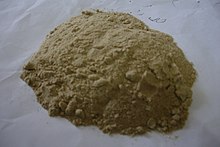Curcuma caesia
This article needs additional citations for verification. (March 2009) |
| Curcuma caesia | |
|---|---|

| |
| Scientific classification | |
| Kingdom: | Plantae |
| Clade: | Tracheophytes |
| Clade: | Angiosperms |
| Clade: | Monocots |
| Clade: | Commelinids |
| Order: | Zingiberales |
| Family: | Zingiberaceae |
| Genus: | Curcuma |
| Species: | C. caesia
|
| Binomial name | |
| Curcuma caesia | |
| Synonyms[1] | |
|
Curcuma kuchoor Royle | |
Curcuma caesia, black turmeric or black zedoary, is a perennial herb with bluish-black rhizomes[2] that is native to northeast India.[3]
Preparation
[edit]

The cultivation and harvest practices are similar to that of common turmeric.[3] In the fields, the rhizomes are washed thoroughly and are placed in a wide mouthed cauldron. The water is poured in the cauldron such that the rhizomes are completely covered. The cauldron is covered with a lid, and the rhizomes are boiled for about 30 minutes until foam oozes out with a strong odour. The rhizomes are taken out when the water is reduced to one-third of the original and they are soft and their inner portion has turned from blue to dark or pale brown. The rhizomes are then dried in hot sun for 10 to 15 days until hardened. These dried rhizomes are then packed for marketing.
Chemical constituents
[edit]The research on the volatile rhizomes oil of Curcuma caesia resulted in the identification of 30 components, representing 97% of the oil, with camphor (28%), ar-turmerone (12%), (Z)-ocimene (8%), ar-curcumene (7%), 1,8-cineole (5%), elemene (5%), borneol (4%), bornyl acetate (3%) and curcumene (3%) as the major constituents.[citation needed] Other research demonstrated diphenylalkanoids, allylbenzene derivatives, terpenoids, flavonoids, steroids, and alkaloids as major constituents.[4]
References
[edit]- ^ "Curcuma caesia Roxb.". World Checklist of Selected Plant Families. Royal Botanic Gardens, Kew. Retrieved 9 March 2014 – via The Plant List. Note that this website has been superseded by World Flora Online
- ^ Syamkumar, S.; B. Sasikumar (March 2007). "Molecular marker based genetic diversity analysis of Curcuma species from India". Scientia Horticulturae. 112 (2): 235–241. doi:10.1016/j.scienta.2006.12.021.
- ^ a b Ravindran, PN; K Nirmal Babu; K Sivaraman (2007). Turmeric: The Genus Curcuma. CRC Press. p. 11. ISBN 978-0-8493-7034-2.
- ^ Sun, W; Wang, S; Zhao, W; Wu, C; Guo, S; Gao, H; Tao, H; Lu, J; Wang, Y; Chen, X (2017). "Chemical constituents and biological research on plants in the genus Curcuma". Critical Reviews in Food Science and Nutrition. 57 (7): 1451–1523. doi:10.1080/10408398.2016.1176554. PMID 27229295. S2CID 20902215.
